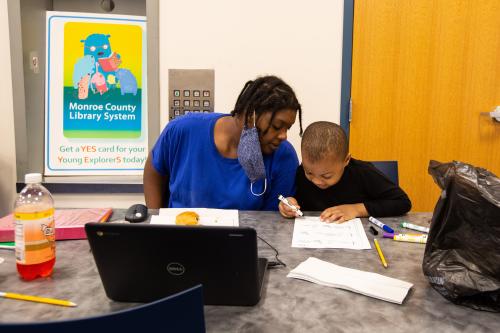The challenges facing elementary schools this coming year will be huge. Large numbers of children will begin school having missed a year of kindergarten, and many others will have fallen behind after struggling with remote learning for long periods during the COVID-19 pandemic. As a result, elementary school teachers will undoubtedly need significant help from other adults such as teacher assistants, health-care providers, and social workers. Only with such support will regular teachers be in a position to address the varied and multiple challenges that children will bring to the classroom in the post-pandemic period.
But how important are teacher assistants? The potential contribution of teacher assistants (TAs) to student learning appears to have been underappreciated in the past. In North Carolina, for example, state policymakers responded to the Great Recession by substantially reducing funding for teacher assistants, a decision driven in part by their belief that teacher assistants were not a cost-effective investment.
That belief was largely based on the findings of the well-known Tennessee STAR experiment that was carried out in the mid-1980s. That random assignment study was designed to explore the effects of smaller class sizes and, secondarily, of the use of teacher aides on student achievement. Despite the clear positive benefits of smaller class sizes—and, in turn, of an increase in the number of teachers per student—the study found few, if any, benefits were associated with the presence of teacher assistants.
Subsequent research has challenged that conclusion. Our recent study of teacher assistants in North Carolina elementary schools during the period 2001-2012, which includes the Great Recession, finds that teacher assistants boost academic outcomes for students, most clearly in reading.
Research from North Carolina on the Effects of TAs on Student Achievement
Nationally, TAs account for approximately 12% of the total elementary and secondary labor force and perform a variety of roles in classrooms. These include preparing classroom activities, working on instruction with individuals and in small groups, managing student behavior, and helping to evaluate student work. Using TAs in any of these roles has the potential to free up time for teachers to focus on their main task of teaching and to make it easier to offer specialized instruction within classrooms. North Carolina does not require TAs to have any form of professional license, but all the state’s districts require TAs to have a high school diploma, and a majority of them require two years of higher education or an associate degree.
Our empirical challenge, and the challenge facing any study of staff effectiveness, was to rule out the possibility of reverse causation; that is, the possibility that staffing levels themselves might be determined in part by student outcomes. The estimated positive effects of teacher assistants, for example, might be overstated if, relative to other districts, those that hired more TAs served higher-performing students. Similarly, the effects might be understated if districts serving lower-performing students had access to more TAs.
North Carolina’s distinctive allocation-based approach to funding its schools permitted us to circumvent biases of this type because base allocations of staff to districts are a formulaic function of enrollments and thus outside the direct control of district leaders. The state does not adjust any of the base staffing allotments to address the differing conditions of local districts (and instead does so through a variety of categorical programs). Thus, we used variation in these allocations over time within districts—along with a variety of additional controls for the characteristics of students, teachers, and local economic conditions—to estimate plausibly causal effects of TAs on student outcomes in elementary schools during our sample period.
We found that TAs in the state’s elementary schools had positive effects on student test scores in both reading and math—with the largest, most consistent, and most robust effects in reading. We then compared the expected change in test scores that would result from the addition of one more staff member per 100 students of each type—teachers and TAs—alongside differences in average salaries to generate a rough approximation of the relative cost-effectiveness of TAs. The performance effects of TAs were smaller than those of regular teachers, but given the lower salaries of TAs than of teachers, they were sufficiently large to make TAs a cost-effective way to improve student achievement, at least in reading. In addition, we found that TAs have larger positive effects on the academic performance of students of color than on other students and suggestive evidence that effects are larger in high-poverty districts than in other districts.
Although this particular study is based on only one state, it adds to the limited, recent work on an understudied staffing category likely to be of high relevance to schools and districts as they grapple with the ongoing challenges of the pandemic. Indeed, our findings are consonant with recent, high-quality experimental evidence from Denmark. That random assignment study demonstrated that TAs of two types—those with and without teaching degrees—both had positive effects on reading outcomes, especially for students from families without a college-educated parent. The authors speculated that TAs with teaching degrees served as a flexible form of class-size reduction, while the aides without degrees—those more similar to TAs in the U.S.—appeared to work more as parts of professional teams focused on reducing classroom behavioral problems and complementing pedagogical efforts by the lead teachers.
Of course, student achievement as measured here by test scores in reading and math is not the only goal of schooling. Clearly teachers, TAs, health providers, and other staff members may contribute in a variety of other ways to the valued outcomes of the education process. And that is likely to be especially true during the post-pandemic period.








Commentary
Teacher assistants are needed—now more than ever
August 24, 2021